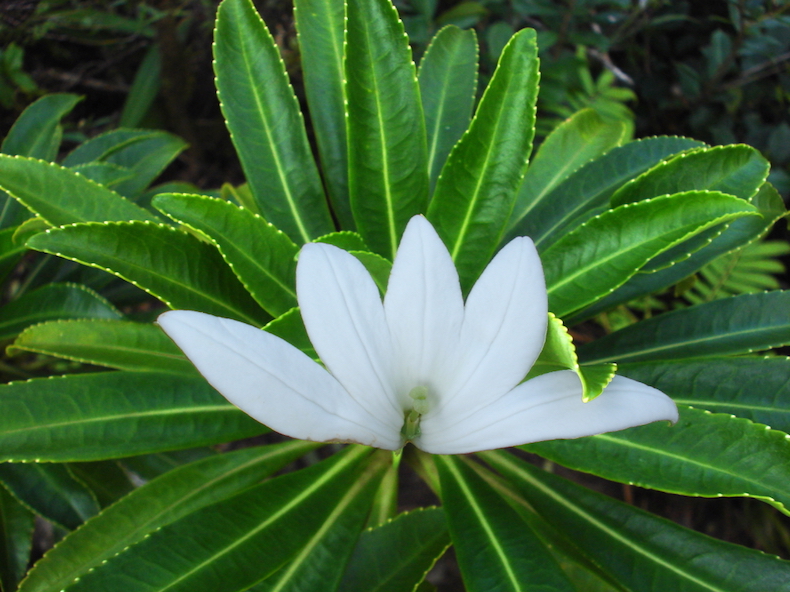 About 150 miles northwest of Tahiti lies Raiatea, 65 square miles, and the spiritual center of the Polynesian world. This week, a holy site there, Taputapuatea, was added to the list of UNESCO world heritage sites.
About 150 miles northwest of Tahiti lies Raiatea, 65 square miles, and the spiritual center of the Polynesian world. This week, a holy site there, Taputapuatea, was added to the list of UNESCO world heritage sites.
Another world-famous marvel on the island is the tiare apetahi, an incredibly rare flower found only on Raiatea, and only on the high plateaus in the center of the island. The common tiare is a flower that grows all over the Pacific. It is in the gardenia family, and has a lovely scent. In Tahiti, it is often used used to make flower necklaces called heis (like Hawaiian leis) and flower crowns.
But the tiare apetahi sports just half a corolla of five petals, looking a bit like a fingered hand—a resemblance that comes up in a local legend about the flower.
Alas, like so many rare and beautiful things, the tiare apetahi is being loved to death. In a recent story in the newspaper la Dépêche de Tahiti, correspondent Jean-Pierre Besse recounts how 81% of the plants have died since 1995, mostly due to souvenir-hunting tourists who snap off bits of the bushes, often resulting in the death of whole limbs or plants. In response, the students of the mechanics class of the Protestant vocational school Tuteao a Vaiho of Uturoa have built physical cages to surround the remaining bushes.
Islands are worlds in miniature and, where ecology is concerned, they are often tiny versions of the future. Ecological change is faster and more dramatic on small isolated islands. Non-native species, rapacious hunting or collecting, pollution, sea-level rise—all are more dangerous where there’s little space and no place to run to.
Putting a stainless steel cage around a rare flower is a sobering image to confront when thinking about the future of our world. Extreme measures in conservation are not new. Already, the Guam Kingfisher waits in protective custody for humans to rid its island of the exotic brown tree snake; the Hawaiian crow or ʻalalā languishes at the San Diego Zoo; and the last toromiro trees yearn for Easter Island from Kew Gardens outside London. But the tiare apetahi, which apparently resists transplantation, is the first plant I’ve heard of to be transferred into “captivity” in situ. If all the plants have cages built around them, then has it become “extinct in the wild”? Or do the cages become an extended part of its morphology—a deterrent supplied by humans to a plant with neither thorns nor poisons to keep away the selfish and greedy—much the way our phones have become extensions of our memories and minds?
Most simply, the cage is a message from the students to the tourists: you can’t be trusted not to destroy this species. The students can’t cage up the tourists, though I am sure they would be tempted if they could. I suppose the real deep work of environmentalism is to create a global culture in which cages wouldn’t be needed.
We all know that many of the species with which we share the planet are in danger because of humanity’s actions. Things are bad—but not so bad that most of the world’s endangered species cannot yet be saved. There is still time to stave off the “6th great mass extinction” that you may have heard has already begun. There is still time!
We know what we need to do. Now we must simply do it. Reduce emissions drastically; set undeveloped land aside; reduce our footprints in land, water, carbon, etc; educate women and work for easy and socially acceptable family planning worldwide; commit to making our decisions on behalf of all species and not just ourselves. Stop picking the tiare apetahi! Maybe in our lifetimes the flowers can be uncaged.
Image from Wikimedia Commons, from 100zax.
Our greed, our self interest and our general lack of caring is boundless. Humans are a very messy species.
Thanks for the article.